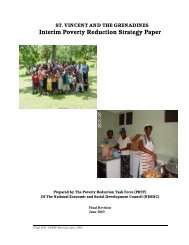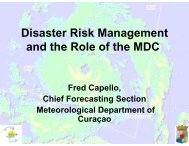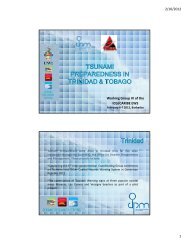The Anatomy of A Silent Crisis The Anatomy of A Silent Crisis
The Anatomy of A Silent Crisis The Anatomy of A Silent Crisis
The Anatomy of A Silent Crisis The Anatomy of A Silent Crisis
- TAGS
- anatomy
- www.bb.undp.org
Create successful ePaper yourself
Turn your PDF publications into a flip-book with our unique Google optimized e-Paper software.
Glossary<br />
> Glossary and<br />
abbreviations<br />
Adaptation: In this report, adaptation refers to individual or governmental actions to reduce adverse<br />
effects or future risks associated with climate change. <strong>The</strong> IPCC defines adaptation as the<br />
“adjustment in natural or human systems in response to actual or expected climatic stimuli or<br />
their effects, which moderates harm or exploits beneficial opportunities.”<br />
Affected persons: Persons affected by climate change have seen their livelihoods compromised<br />
temporarily or permanently by climate change.<br />
Attribution <strong>of</strong> climate change: Effort to scientifically ascertain mechanisms responsible for relatively<br />
recent changes observed in the Earth’s climate, i.e. variations in temperature, weather-related<br />
disasters and disease levels. <strong>The</strong> dominant mechanisms include manmade activities which<br />
increase greenhouse gases, release aerosols, and cause land surface changes like deforestation.<br />
Climate Change Vulnerability Indicator (CCVI): Developed by Maplecr<strong>of</strong>t, the CCVI is an attempt<br />
to quantify and map vulnerability to the impacts <strong>of</strong> climate change at the sub-national level.<br />
‘Vulnerability’ is defined as a combination <strong>of</strong> factors that influence the capacity <strong>of</strong> individuals,<br />
communities, economies and societies to reduce the risks from changes in patterns <strong>of</strong> natural<br />
hazards and impacts on ecosystem services as a result <strong>of</strong> climate change. <strong>The</strong> CCVI does not<br />
attempt to predict changes to patterns <strong>of</strong> natural hazards or ecosystems as a result <strong>of</strong> climate<br />
change. Six groups <strong>of</strong> climate change vulnerability factors make up the CCVI: economy; natural<br />
resources and ecosystems; poverty, development and health; agriculture; population, settlement<br />
and infrastructure; and institutions, governance and social capital. A sub-index was developed for<br />
each group and these were combined to form the CCVI. <strong>The</strong> natural resources and ecosystems<br />
and agriculture sub-indices are weighted twice as heavily as the others in the overall CCVI.<br />
Climate Displaced People: Climate displaced people is the term used in this report describing<br />
people who predominantly involuntarily are forced to move or are displaced, either<br />
permanently or temporarily, because <strong>of</strong> climate change, through its impacts and shocks. It<br />
is possible to estimate the numbers <strong>of</strong> Climate Displaced People in global terms, since, for<br />
instance, a correlation can be made between the great increase in the number <strong>of</strong> severe<br />
weather events — much <strong>of</strong> which can be attributed to climate change — over the last<br />
decades, and the number <strong>of</strong> additional people that these events displace. It is, however,<br />
virtually impossible to single out individual people or even scenario specific situations as being<br />
attributable to climate change. This means that the definition <strong>of</strong> Climate Displaced People<br />
carries almost no practical application today. It is however, a useful estimative indicator <strong>of</strong> the<br />
93







